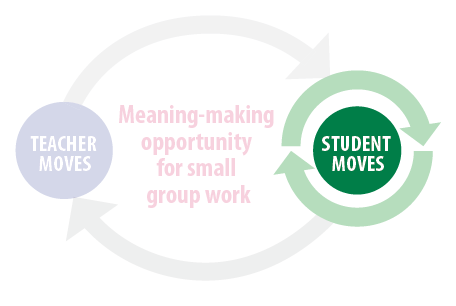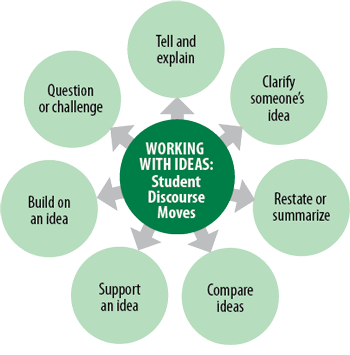

When we present students with intriguing challenges to think through, some will jump right in and others will hold back. To activate collaborative thinking and discussion--the engine driving language development—we need to help students learn and practice new ways of interacting. Our work on this was inspired by the work of Zwiers, O’Hara, & Pritchard (2014) on constructive conversations and Michaels & O’Connor (2012) on the Talk Science Primer. We’ve put the ideas together a bit differently, and developed this short version for those interested in testing the power of a discourse-focused pedagogy. When you’ve seen what it can do for you and your students, the Resource page will show you where to go to learn more.

The Student Moves highlight seven things students can do when an idea is on the table. Teachers have found that this graphic serves as a good meta-cognitive support. The expectation that all students are always responsible, every minute, for tracking the development of an idea and for being ready with a response that furthers their own understanding is a new one for many students, and they need time and guidance to engage effectively. Teachers can support students’ use of these moves by being overt about the naming of both Teacher Moves and Student Moves as they take place. We’ve heard one teacher do this very playfully: “I like the way you moved that move there!”
The full version of the Student Moves on the Resources page offers examples of language students can use. ELs relied on them for a longer period than their classmates, and having them nearby seemed to help them speak more often and more confidently. It’s important to make sure students see these only as examples and to encourage students to create additional ways of saying these things. It can also be helpful to keep a running list somewhere of additional student-generated language
Teachers found it best to focus on one Student Move at a time. They posted the graphic of all the moves, and referred to them as they came up in discussions, but focused on one move at a time in their instruction. Some moves took longer for students to learn than others, but before long, teachers noted that students were learning newly introduced moves pretty quickly. Some fourth-grade teachers created color-cued bookmarks for their students, each having one Student Move with multiple examples of phrasings and some blank spots for students to create their own. These were helpful to the ELs, in particular, but we observed a wonderful interaction in one classroom when an EL could not find his bookmark and another student reassured him, “There are lots of ways to say that. You could say…or… .” This was one of several examples we observed of students learning language from and with one another.
“Our ELs are speaking up and offering ideas in ways they never did before. They feel smart now, and they feel proud, and they’re willing to take risks with their language to share their thinking.”
a fourth grade teacher
Student Moves in Math